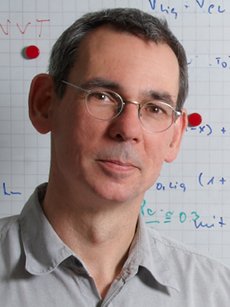
professional CV:
1977-1983 enrolled in the physics program of the University at Osnabrück, GERMANY, where he graduates with a MS degree in physics with a thesis on "Auger Neutralization of Slow Hydrogen-Like Ions at Jellium Surfaces".
1983-1987 enrolled in the Ph.D. program in physics at the University of Maine, Orono, Maine, USA, where he receives his Ph.D. in physics with a thesis entitled "Application of Conformal Invariance to the Investigation of Second Order Surface Phase Transitions" under the supervision of Prof. Dr. Peter Kleban.
1987 visiting scientist at the Department of Chemistry, Baker Laboratory, Cornell University, New York, USA.
1987-1989 postdoctoral researcher in the group of Prof. Dr. Judith Herzfeld at the Department of Chemistry, Brandeis University, Massachusetts USA.
1990-1999 staff scientist in the group of Prof. Dr. Gerhard Wegner at the Max-Planck Institute for Polymer Research, Mainz, GERMANY; 1996 Habilitation and venia legendi in Physical Chemistry at the Department of Chemistry, Gutenberg University, Mainz, GERMANY.
1999-present professor of theoretical chemical physics at the Bergische University, Wuppertal, GERMANY.
primary research interests
His research interests have frequently straddled the boundary between physics and chemistry. Early work as a Master and PhD student has focussed on surface physics dealing with topics in molecule/ion-surface collision and surface phase transitions. During his postdoctoral years the focus shifted to theoretical physical chemistry of reversible molecular aggregation as found in micellar and protein systems and the attendant liquid crystalline phase behaviour. As a scientist at the Max-Planck Institute for Polymer Research he has concentrated on computer modelling of polymers.
Over the past years, as a professor of physics in Wuppertal, his work has been a synthesis of these earlier fields of work. Recently his group has concentrated on (a) the theoretical investigation of sorption in polymer networks using computer simulation methods and lattice theory; (b) reversible self-assembly and phase behaviour of equilibrium polymers using again a combination of computer simulation and analytical theory; (c) dielectric properties in conjunction with the structural phase behaviour of dipolar fluids; (d) the development of computer algorithms for molecular modelling. Even more recently he has become interested in theoretical problems encountered in elastomer technology.
